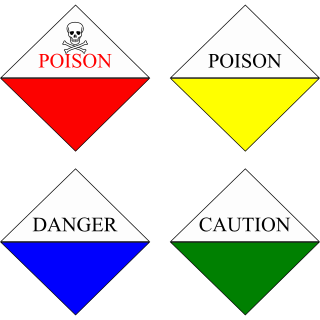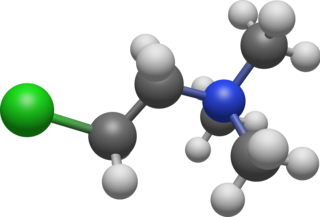
Pesticides are substances that are used to control pests. They include herbicides, insecticides, nematicides, fungicides, and many others. The most common of these are herbicides, which account for approximately 50% of all pesticide use globally. Most pesticides are used as plant protection products, which in general protect plants from weeds, fungi, or insects. In general, a pesticide is a chemical or biological agent that deters, incapacitates, kills, or otherwise discourages pests. Target pests can include insects, plant pathogens, weeds, molluscs, birds, mammals, fish, nematodes (roundworms), and microbes that destroy property, cause nuisance, or spread disease, or are disease vectors. Along with these benefits, pesticides also have drawbacks, such as potential toxicity to humans and other species.
A biocide is defined in the European legislation as a chemical substance or microorganism intended to destroy, deter, render harmless, or exert a controlling effect on any harmful organism. The US Environmental Protection Agency (EPA) uses a slightly different definition for biocides as "a diverse group of poisonous substances including preservatives, insecticides, disinfectants, and pesticides used for the control of organisms that are harmful to human or animal health or that cause damage to natural or manufactured products". When compared, the two definitions roughly imply the same, although the US EPA definition includes plant protection products and some veterinary medicines.

Piperonyl butoxide (PBO) is a pale yellow to light brown liquid organic compound used as an adjuvant component of pesticide formulations for synergy. That is, despite having no pesticidal activity of its own, it enhances the potency of certain pesticides such as carbamates, pyrethrins, pyrethroids, and rotenone. It is a semisynthetic derivative of safrole.
Under United States law, pesticide misuse is considered to be the use of a pesticide in a way that violates laws regulating their use or endangers humans or the environment; many of these regulations are laid out in the Federal Insecticide, Fungicide, and Rodenticide Act (FIFRA). The most common instances of pesticide misuse are applications inconsistent with the labeling, which can include the use of a material in any way not described on the label, changing dosage rates, or violating specific safety instructions. Pesticide labels have been criticized as a poor risk communication vehicle, leading some officials and researchers to question whether "misuse" is an appropriate term for what are often "unintended uses" resulting from a poor understanding of safety and application instructions. Other kinds of pesticide misuse include the sale or use of an unregistered pesticide or one whose registration has been revoked and the sale or use of an adulterated or misbranded pesticide. Under most jurisdictions, it is illegal to alter or remove pesticide labels, to sell restricted pesticides to an uncertified applicator, or to fail to maintain sales and use records of restricted pesticides.
Restricted use pesticides (RUP) are pesticides not available to the general public in the United States. Fulfilling its pesticide regulation responsibilities, the United States Environmental Protection Agency (EPA) registers all pesticides as either "unclassified" or "restricted use". Unclassified pesticides are available over-the-counter, while the latter require a license to purchase and apply the product. Pesticides are classified as "restricted use" for a variety of reasons, such as potential for or history of groundwater contamination.

Toxicity class refers to a classification system for pesticides that has been created by a national or international government-related or -sponsored organization. It addresses the acute toxicity of agents such as soil fumigants, fungicides, herbicides, insecticides, miticides, molluscicides, nematicides, or rodenticides.

Acibenzolar-S-methyl is the ISO common name for an organic compound that is used as a fungicide. Unusually, it is not directly toxic to fungi but works by inducing systemic acquired resistance, the natural defence system of plants.

Azoxystrobin is a broad spectrum systemic fungicide widely used in agriculture to protect crops from fungal diseases. It was first marketed in 1996 using the brand name Amistar and by 1999 it had been registered in 48 countries on more than 50 crops. In the year 2000 it was announced that it had been granted UK Millennium product status.

The Food Quality Protection Act (FQPA), or H.R.1627, was passed unanimously by Congress in 1996 and was signed into law by President Bill Clinton on August 3, 1996. The FQPA standardized the way the Environmental Protection Agency (EPA) would manage the use of pesticides and amended the Federal Insecticide, Fungicide, and Rodenticide Act and the Federal Food Drug and Cosmetic Act. It mandated a health-based standard for pesticides used in foods, provided special protections for babies and infants, streamlined the approval of safe pesticides, established incentives for the creation of safer pesticides, and required that pesticide registrations remain current.

Sulfentrazone is the ISO common name for an organic compound used as a broad-spectrum herbicide. It acts by inhibiting the enzyme protoporphyrinogen oxidase. It was first marketed in the US in 1997 by FMC Corporation with the brand name Authority.

Pesticides in the United States are used predominantly by the agricultural sector, but approximately a quarter of them are used in houses, yards, parks, golf courses, and swimming pools.
In United States environmental policy, maintenance fees are the annual fees paid by pesticide manufacturers and formulators to continue registration of pesticide active ingredients and products with the Environmental Protection Agency (EPA). The fees supplement funds appropriated from general U.S. revenues, which cover most administrative costs of the EPA pesticide program under the Federal Insecticide, Fungicide, and Rodenticide Act. Fees are deposited into a separate Reregistration and Expedited Processing Fund to offset costs associated with EPA reregistration activities and expedited processing of pesticide registrations that are substantially similar to registrations already in effect or which are for public health pesticides, as defined in FIFRA Section 2(nn). Congress mandated collection of an annual maintenance fee from each pesticide registrant in 1988 amendments to. EPA has authority to cancel a registration if a registrant fails to pay the maintenance fee.

Saflufenacil is the ISO common name for an organic compound of the pyrimidinedione chemical class used as an herbicide. It acts by inhibiting the enzyme protoporphyrinogen oxidase to control broadleaf weeds in crops including soybeans and corn.

The California Department of Pesticide Regulation, also known as DPR or CDPR, is one of six boards and departments of the California Environmental Protection Agency (Cal/EPA).

Pesticide regulation in the United States is primarily a responsibility of the Environmental Protection Agency (EPA). In America, it was not till the 1950s that pesticides were regulated in terms of their safety. The Pesticides Control Amendment (PCA) of 1954 was the first time Congress passed guidance regarding the establishment of safe limits for pesticide residues on food. It authorized the Food and Drug Administration (FDA) to ban pesticides they determined to be unsafe if they were sprayed directly on food. The Food Additives Amendment, which included the Delaney Clause, prohibited the pesticide residues from any carcinogenic pesticides in processed food. In 1959, pesticides were required to be registered.

Acifluorfen is the ISO common name for an organic compound used as an herbicide. It acts by inhibiting the enzyme protoporphyrinogen oxidase which is necessary for chlorophyll synthesis. Soybeans naturally have a high tolerance to acifluorfen and its salts, via metabolic disposal by glutathione S-transferase. It is effective against broadleaf weeds and grasses and is used agriculturally on fields growing soybeans, peanuts, peas, and rice.

Chlormequat is an organic compound with the formula ClCH
2CH
2N(CH
3)+
3 that is used as a plant growth regulator. It is typically sold as the chloride salt, chlormequat chloride (C5H13Cl2N), a colorless hygroscopic crystalline substance that is soluble in water and ethanol. It is an alkylating agent and a quaternary ammonium salt. Chlormequat is one of the onium-type growth regulators.

The Reducing Regulatory Burdens Act of 2013 is a bill that would prohibit the Environmental Protection Agency (EPA) and states authorized to issue a permit under the National Pollutant Discharge Elimination System (NPDES) from requiring a permit for some discharges of pesticides authorized for use under the Federal Insecticide, Fungicide, and Rodenticide Act (FIFRA). The bill would clarify the law so that people did not have to get two permits in order to use the same pesticide.

Cyproconazole is an agricultural fungicide of the class of azoles, used on cereal crops, coffee, sugar beet, fruit trees and grapes, on sod farms and golf courses and on wood as a preservative. It was introduced to the market by then Sandoz in 1994.

The Circle of Poison (COP) refers to the export of domestically banned pesticides for use on foods elsewhere, some of which returns by way of import. The "circle" is complete when the toxic chemicals that were exported are then used to grow fruit, meat, and produce that are imported and available for domestic consumption. This circle was first identified relative to the United States but the relationship also exists between other nations of the Global North and South.
















